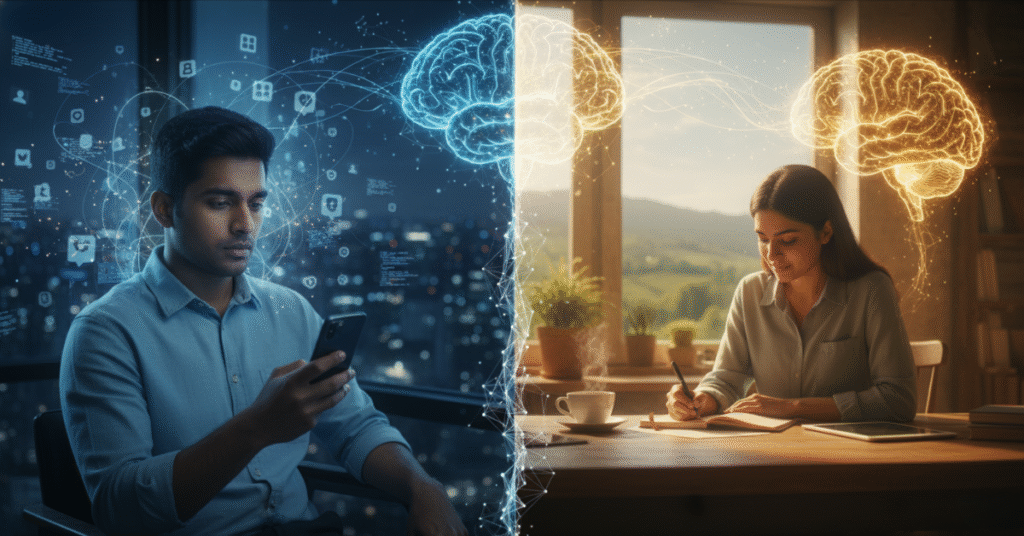How to stop digital amnesia and improve memory is no longer a niche question for tech enthusiasts; it’s a critical challenge for everyone in the 21st century. I’ve personally experienced the frustration—the moment you realize you can’t recall a close friend’s phone number or navigate a familiar route without GPS.
Our constant reliance on smartphones and cloud storage has created a mental outsourcing habit. This habit is leading to what experts call ‘Digital Amnesia‘ or the conceptual term ‘Digital Dementia.’
The good news? Our brains are incredibly adaptable. This detailed guide will show you not only the science behind this modern memory drain but also the practical steps we can take to regain our cognitive edge.
What Exactly is Digital Amnesia and Why Should We Care? (Latest Information)
Digital Amnesia is the phenomenon where people forget information because they trust a digital device to store it for them. It’s not a disease, but a measurable change in our cognitive function.

The latest research confirms that when we know information is readily available on our phone or computer, our brain makes less effort to encode that information into long-term memory. It’s simply an efficiency mechanism—why store a file if the cloud can do it better?
We should care because this outsourcing habit is subtly undermining fundamental cognitive skills:
- Critical Thinking: Memory recall is the foundation of complex problem-solving.
- Spatial Awareness: Relying solely on GPS weakens our innate ability to map and navigate our surroundings.
- The Google Effect: Studies show we’re better at remembering where to find the information (e.g., “Google”) rather than the information itself.
My Journey from Digital Dependency to Cognitive Freedom
Like many of you, my personal life became completely intertwined with my smartphone. I used to joke that my calendar app was my actual brain.
I realized the depth of the problem when, during a power outage last year, I couldn’t remember the emergency number I had dialed countless times, because I only ever used the “Recents” tab.
This personal experience was the catalyst that made me seriously ask: how to stop digital amnesia and improve memory? I started consciously creating “friction”—forcing my brain to work a little harder.
The results were astounding. Within months, my ability to focus, recall details in meetings, and even learn new skills improved noticeably. This article is built on the real strategies I implemented to reverse my own digital dependency.
Scientific Reasons Behind Memory Loss in the Digital Age
The decline isn’t a moral failure; it’s a biological response to the digital environment. Two concepts explain this best:
The Google Effect (Storage Location vs. Storage Content)
This principle highlights that our memory system prioritizes the location of information over the information itself. If you know a search engine, or a specific app, holds the data, your brain tags that external source and saves the effort of internal memorization.
Attention Residue
The constant stream of notifications, emails, and social media updates fragments our focus. Our brain gets stuck in a state of “attention residue,” where parts of our focus remain on the last task (checking a notification) even as we switch to a new one (reading an article). This prevents the deep, focused attention required to move new information from short-term to long-term memory.
The Definitive Action Plan: How to Stop Digital Amnesia and Improve Memory (7 Key Strategies)
To fully address how to stop digital amnesia and improve memory, we must focus on both minimizing outsourcing (reducing digital reliance) and maximizing our cognitive skills (training the brain). Following these steps is the best way to how to stop digital amnesia and improve memory effectively.
Phase 1: Digital Habits Overhaul (Minimize Outsourcing)
- Selective Digital Use: Stop using your phone as a mental crutch for trivial things. Memorize 3-5 frequently called phone numbers. Calculate small tips or expenses manually before using the calculator app. This is the first practical step in how to stop digital amnesia and improve memory.
- Use GPS for the End-Goal Only: Before starting your journey, look at the route on the map once and try to drive the first few turns from memory. Only look at the GPS when you are near the destination. This forces spatial memory engagement.
- Digital Declutter: Turn off non-essential notifications. This is the single most effective way to eliminate ‘Attention Residue’ and allow for deep focus, which is crucial for memory encoding.
Phase 2: Mind-Gym Exercises (Boost Internal Storage)
- The Mnemonic Technique: Use mnemonics for memorizing lists or sequences. For example, creating a ridiculous story to remember your grocery list. This technique forces your brain to create strong, imaginative connections that are easy to recall.
- The Method of Loci (Memory Palace): For complex or long lists, associate each item with a specific location in a familiar place (like your house). To recall the information, take a mental walk through your house. This technique is thousands of years old and highly effective in helping you how to stop digital amnesia and improve memory.
- Handwriting over Typing: When taking notes for learning, use a pen and paper. Studies consistently show that the physical act of writing engages more parts of the brain and significantly improves retention compared to typing.
Phase 3: Lifestyle for Cognitive Health
Memory improvement is a holistic process. You cannot fully grasp how to stop digital amnesia and improve memory without addressing the brain’s fuel:
- Prioritize Sleep: During deep sleep, the brain consolidates memories from the day. Aim for 7-9 hours of quality sleep.
- The Power of Exercise: Regular aerobic exercise increases blood flow to the hippocampus, the brain’s primary memory centre, promoting the growth of new neural connections.
Achieving Results in 30 Days (A Realistic Outlook)
While reversing Digital Amnesia is a long-term commitment, focusing on these 7 proven steps consistently for 30 days will allow you to see tangible results. The brain begins forming new habits and neural pathways almost immediately. By the end of one month, you will notice significant improvements in recall efficiency, focus span, and a reduced urge to immediately reach for your phone for basic information. This 30-day period is your initial challenge to cognitive freedom.
By consciously challenging your memory and being mindful of how you interact with technology, you can successfully reverse Digital Amnesia and enhance your overall cognitive ability. Don’t let your phone be your brain; let it be your tool.

